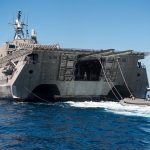US Navy testing aerial laser
 The US Navy is testing an aerial laser that can detect underwater mines, and it could change naval warfare
The US Navy is testing an aerial laser that can detect underwater mines, and it could change naval warfare
By Kris Osborn, Warrior Maven From Business Insider
The US Navy used an MH-60S helicopter-mounted laser system to scan and detect underwater mine-like targets during the ongoing multi-national Rim of the Pacific exercise, marking the first operational use of an emerging technology bringing much faster detection and a wider Field of View to countermine missions.
The now-operational technology, called Airborne Laser Mine Detection System (ALMDS), enables efficient, high-speed shallow-water mine detection for the Navy’s Littoral Combat Ship.
“This is the first opportunity for a non-test-centric fleet exercise. It has been placed in sailors’ hands and we are looking forward to getting training feedback and tactics feedback. This is the first real operational exercise,” Capt. Danielle George, Program Manager, Mine Warfare, told Warrior Maven in an interview.
George said that the Navy is now analyzing findings and key data emerging from the RIMPAC exercises.
“Another system performs post-mission analysis. ALMDS collects all the data and when the helo returns, it will download. Then you have options for how you can destroy the mine,” George said.
Instead of using more narrowly configured, mechanized or towed mine-detection systems, ALMDS massively expands the surface area from which mine detection takes place. Naturally, this enables shallow-water warships such as the LCS have a much safer sphere of operations as commanders will have much greater advanced warning of mine-cluttered areas.
The ALMDS pod is mechanically attached to the MH-60S with a standard Bomb Rack Unit 14 mount and electrically via a primary and auxiliary umbilical cable to the operator console, according to a statement from the systems maker, Northrop Grumman.
“It does not use any bombs. It flies at a certain altitude and a certain speed. The laser emits beams at a certain rate. Cameras underneath the helicopter receive reflections back from the water. The reflections are processed to create images displayed on a common consol on the helicopter,” Jason Cook, the Navy’s Assistant Program Manager, ALMDS, told Warrior Maven in an interview.
Cook explained that the camera or receiver on the helicopter is called a Streak Tube Imaging LIDAR (STIL). The laser is released in a fan pattern, and photons received back are transferred into electrons, create a camera-like image rendering.
“Instead of a human out searching and sweeping, ALMDS achieves a higher rate of speed and covers a lot more area,” he added.
Northrop information on ALMDS further specifies that the system can operate in both day and night operations without stopping or towing equipment in the water.
“Allowing untethered operations, it can attain high area search rates. This design uses the forward motion of the aircraft to generate image data negating the requirement for complex scanning mechanisms and ensuring high system reliability,” Northrop information states.
Having this technology operational, it seems, offers a few new strategic nuances. First and foremost, detecting mines more quickly and at further ranges of course makes the LCS much more survivable. It will be able to pursue attack, anti-submarine and reconnaissance missions with a much lower risk of mine attack. Furthermore, identifying the location of mines at greater distances brings the added advantage of enabling lower-risk small boat missions to approach target areas for shore missions, surface attack or recon.
Also, given that attack submarines are routinely able to launch attacks, conduct recon and access enemy areas in closer proximity to island and coastal areas, compared with many deeper draft larger surface combatants, ALMDS could measurably improve submarine operations.
Finally, given that the LCS is engineered for both autonomous and aggregated operations, ALMDS could provide occasion for the ship to alert other surface and undersea vessels about the location of enemy mines. In fact, Northrop writes that ALMDS provides accurate target geo-location to support follow-on neutralization of the detected mines.
Along these lines, George explained that ALMDS is oriented toward shallow portions of the water column, thus bringing a special littoral tactical advantage; the ALMDS will eventually be integrated into the LCS’ Mine Countermeasures mission package.
Some of the technical details of the system are further delineated in a research paper written by Arete Associates — a science and technology consulting firm with a history of supporting entities such as the Office of Naval Research and the Air Force.
“A high resolution 3-D image of the scene is produced from multiple sequential frames formed by repetitively pulsing the laser in synchrony with the CCD (Charge Coupled Device) frame rate as an airborne platform “push broom” scans or as a single-axis scanner on a ground-based platform scans the laser fan beam over the scene,” the Arete Associates essay titled “Streak Tube Imaging LIDAR For 3-D Imaging of Terrestrial Targets, writes. “The backscattered light from the objects and the terrain intersecting the fan beam is imaged by a lens.”
STIL technology, while only recently becoming operational with ALMDS, has been in development as a maritime surveillance system for many years. A 2003 study from the Naval Surface Warfare Center cites how “pulsed light” sent out from a three-dimensional electro-optic sensor STIL system can “identify objects of interest on the ocean bottom.”
The Arete essay also talk about STIL technology also being developed and tested for use as a “missile seeker” by weapons and a sensor system for an Air Force C-130 aircraft.
Read the original article on Warrior Maven.
All Scout Warrior content has now moved to www.warriormaven.com
Copyright 2018. Follow Warrior Maven on Twitter.
IMAGES:
MH 60 Seahawk An MH-60 Seahawk. US Navy
USS Coronado Littoral Sailors prepare to be hoisted out of the water by the littoral combat ship USS Coronado’s (LCS 4).Mass Communication Specialist 2nd Class Debra Daco/US Navy
MH-60S Seahawk on USS Coronado flight deck An MH-60S Seahawk on the flight deck of the littoral combat ship USS Coronado. US Navy
US Navy helicopter Northrop Grumman ALMDS laser mine detection A US Navy helicopter outfitted with an Airborne Laser Mine Detection System.Northrop Grumman
For more on this story go to; https://www.businessinsider.com/navy-uses-helicopter-mounted-laser-against-mines-for-first-time-2018-7?utm_source=feedburner&%3Butm_medium=referral&utm_medium=feed&utm_campaign=Feed%3A+businessinsider+%28Business+Insider%29








